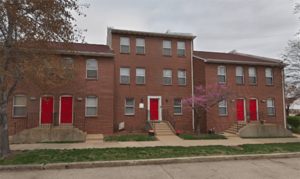Robert Rayford facts for kids
Quick facts for kids
Robert Lee Rayford
|
|
|---|---|
| Born | February 3, 1953 St. Louis, Missouri, U.S.
|
| Died | May 15, 1969 (aged 16) St. Louis, Missouri, U.S.
|
| Cause of death | AIDS-related complications |
| Known for | Alleged first known AIDS death in the United States |
Robert Lee Rayford (born February 3, 1953 – died May 15, 1969) was an American teenager from Missouri. He is thought to be the first known case of HIV/AIDS in North America. Doctors were puzzled by his symptoms. He died from pneumonia, but later tests showed he had a virus similar to HIV.
Contents
Robert Rayford's Early Life
Robert Rayford was born in St. Louis, Missouri, on February 3, 1953. His mother, Constance Rayford, raised him and his older brother, George. They lived in the Old North neighborhood of St. Louis. This area had affordable homes for many working-class African-American families.
People called Robert "Bobbie." He was described as very shy and quiet. He was also said to be a bit slow in his learning.
Robert's Mysterious Illness
In early 1968, when Robert was 15, he went to the City Hospital in St. Louis. Doctors found a serious infection that had spread throughout his body. Dr. Memory Elvin-Lewis was one of the doctors who treated him. She remembered Robert as a shy teenager who didn't talk much to adults.
Later, Robert was moved to Barnes-Jewish Hospital. His health seemed to get better for a while. But by March 1969, his symptoms returned and got worse. He had trouble breathing, and his body's ability to fight off sickness was failing. Doctors found that his immune system was not working well. He developed a fever and sadly died on May 15, 1969, from pneumonia.
What the Autopsy Showed
After Robert died, doctors performed an autopsy to understand what happened. Dr. William Drake led this examination. They found unusual purple spots on Robert's left thigh. Dr. Drake believed these spots were Kaposi's sarcoma. This is a rare type of cancer that usually affects older men. It was very unusual to see it in a black teenager.
Later, Kaposi's sarcoma was identified as a sign of AIDS. These findings confused the doctors at the time. A report about Robert's case was published in a medical journal in 1973.
Later Discoveries and Tests
How HIV Was Discovered
In 1984, scientists discovered HIV. This virus was spreading quickly in cities like New York City and Los Angeles. Dr. Marlys Witte, who had cared for Robert, decided to test some of his preserved tissue samples. At first, the tests for HIV came back negative.
Testing Robert's Samples Again
In 1987, Dr. Witte tried again using a more sensitive test called Western blot. This time, the test found antibodies against HIV in Robert's blood. Antibodies are what your body makes to fight off infections. This meant Robert's body had fought against HIV.
Scientists also tried to find HIV's genetic material (DNA) in his tissues. In 1999, a study at a science conference reported finding HIV genes in Robert's samples. These genes were very similar to a known type of HIV. However, this study was never officially published in a medical journal.
Sadly, the last known tissue samples from Robert were destroyed during Hurricane Katrina in 2005. This meant no more tests could be done.
Why Robert's Case Was Important
Robert Rayford never left the Midwestern United States. He also told doctors he never had a blood transfusion. Because of this, researchers believe that HIV might have been present in North America earlier than thought. Robert's case suggests the virus was around before he even started showing symptoms in 1966.
See also
- Arvid Noe, the earliest known European AIDS case
- Index case
- History of HIV/AIDS
- Timeline of early AIDS cases
- Timeline of HIV/AIDS


